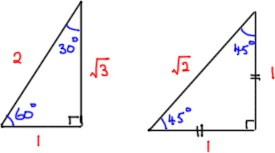What are exact ratios in trigonometry?
Hi. I have a task: Using exact ratios, show that
sin^2 60*sec60* - cosec60*= (9-4√3)/6
Could please explain what "Using exact ratios" means?
Cheers
sin^2 60*sec60* - cosec60*= (9-4√3)/6
Could please explain what "Using exact ratios" means?
Cheers

Original post by Brutal
Hi. I have a task: Using exact ratios, show that
sin^2 60*sec60* - cosec60*= (9-4√3)/6
Could please explain what "Using exact ratios" means?
Cheers
sin^2 60*sec60* - cosec60*= (9-4√3)/6
Could please explain what "Using exact ratios" means?
Cheers

Trigonometric values for angles 30, 45, 60, 90... Can be found exactly by a drawing of an equilateral or right isosceles triangle and using Pythagoras.
Clue: Find the vertical height of an equilateral triangle of side unit length.
(edited 8 years ago)
Original post by Brutal
Hi. I have a task: Using exact ratios, show that
sin^2 60*sec60* - cosec60*= (9-4√3)/6
Could please explain what "Using exact ratios" means?
Cheers
sin^2 60*sec60* - cosec60*= (9-4√3)/6
Could please explain what "Using exact ratios" means?
Cheers

sin 60 = sqrt(3)/2, cos 60 = 1/2. Thus the expression becomes:
3/4 * 2 - 2/sqrt(3)
= 3/2 - 2sqrt(3)/3 by rationalising the denominator
= (9-4sqrt(3))/6 since 3/2 = 9/6 and 2sqrt(3)/3 = 4sqrt(3)/6.
QED
Don't even get me started on exact trig values. They really interest me for some reason. You can find all sine values for integer angles (degrees). Even can be found exactly and from there you can find them all.
But yeah for these questions just use the exact value of sin(60) and cos(60) and you'll have to rationalise the denominator along the way until you get it into the very attractive form on the right hand side as you posted.
But yeah for these questions just use the exact value of sin(60) and cos(60) and you'll have to rationalise the denominator along the way until you get it into the very attractive form on the right hand side as you posted.
Original post by Ano123
Don't even get me started on exact trig values. They really interest me for some reason. You can find all sine values for integer angles (degrees). Even can be found exactly and from there you can find them all.
But yeah for these questions just use the exact value of sin(60) and cos(60) and you'll have to rationalise the denominator along the way until you get it into the very attractive form on the right hand side as you posted.
But yeah for these questions just use the exact value of sin(60) and cos(60) and you'll have to rationalise the denominator along the way until you get it into the very attractive form on the right hand side as you posted.
Have you read through ptolemy's construction of trigonometric tables. I believe that's where we get Ptolemy's Theorem from.
Original post by EricPiphany
Have you read through ptolemy's construction of trigonometric tables. I believe that's where we get Ptolemy's Theorem from.
I have briefly.
@Brutal @EricPiphany

The Right angled triangle on the left is one half of an equilateral triangle.

The Right angled triangle on the left is one half of an equilateral triangle.
(edited 8 years ago)
Original post by Ano123
Even can be found exactly.
Here it is.

Unfortunately, the answer involves the cube roots of complex numbers. If you are looking for 'nice' algebraic forms for trigonometric functions in degrees you need to stick to the multiples of 3.
(edited 8 years ago)
Original post by Mr M
Here it is.

Unfortunately, the answer involves the cube roots of complex numbers. If you are looking for 'nice' algebraic forms for trigonometric functions in degrees you need to stick to the multiples of 3.

Unfortunately, the answer involves the cube roots of complex numbers. If you are looking for 'nice' algebraic forms for trigonometric functions in degrees you need to stick to the multiples of 3.
It's beautiful.
Quick Reply
Related discussions
- What topics are NOT in the non calculator paper in GCSE maths?
- 2022 Edexcel Maths GCSE (Higher) Checklist
- Topics list for Paper 4 OCR maths gcse
- Does anyone have a gcse maths topic list per paper?
- biochemistry access course help
- GCSE Maths Trigonometry
- Trigonometry
- Calculator not giving exact answers
- OCR GCSE Maths Paper 6 (Higher)
- Biology pentose sugars
- a level physics
- Is anyone studying Construction Project Management at Sheffield Hallam?
- Chemistry mass spectrometry .HELP PLS !!!
- Trapezium question - URGENT help needed!
- Sequence and series
- chem moles titrations
- Teenagers find an "impossible" proof of Pythagoras' Theorem
- gcses
- Why do we need to know the exact trig values for A level math?
- lancaster uni cs
Latest
Trending
Last reply 3 days ago
Did Cambridge maths students find maths and further maths a level very easy?Last reply 2 weeks ago
Edexcel A Level Mathematics Paper 2 unofficial mark scheme correct me if wrongMaths
71
Trending
Last reply 3 days ago
Did Cambridge maths students find maths and further maths a level very easy?Last reply 2 weeks ago
Edexcel A Level Mathematics Paper 2 unofficial mark scheme correct me if wrongMaths
71




